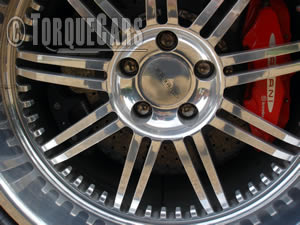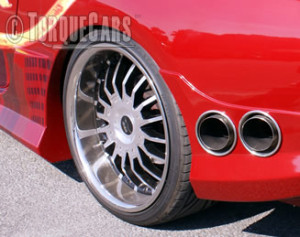Wheel modifications and upgrades
"Keeping it wheel"
One of the most popular modification done on cars is replacing the wheels. We will look at the types of wheel available, the pros and cons of each and look at the implications of fitting different size wheels.
We will be challenging the concept of wider wheels giving more grip and looking at the effect a larger rim size has on a cars performance.
The wheels should never be underestimated as this is the only contact the car has with the road.
Unsprung weight, what is it and why is it bad?
Most of the car is Sprung, that is the vertical and to some degree lateral movement is controlled or dampened by the suspension.
When things change direction or speed you lose energy. The suspension in a car is attempting to keep the wheels in contact with the ground. In a wheel travelling over a rough surface you will be losing energy as it bounces and skips over the road, the more mass in the wheel the harder it is to control these undulations. This is simple physics really, a heavy object requires more energy to move and stop than a lighter one. When you start rotating an object rotational forces come into play, much like a gyroscope and the heavier the wheel the more resistant it is to directional changes. The faster the wheel rotates the greater the gyroscope effect is so the weight of a wheel is magnified due to the rotation.
The lower the weight of the wheel is the more inclined it will be to respond when you want to change direction when you turn a corner, slow up or accelerate. So you really want your wheels to be as light as possible and not too high.
Myths about wider wheels and grip.
It is often thought that wider wheels will increase the cars grip. It should be noted that this is a wild generalisation. Wider wheels still have a similar contact area to narrow wheels! The weight of the car is spread over a wider contact patch area but this contact patch is much shorter and the overall surface area is similar.
In cars you will usually find that in the wet and snow a narrower tyre is able to cut through to the road surface and grip better than larger wheels. (Tread depth also comes into play here as well.) In a wider tyre more water or snow is trapped under the tyre effectively lifting it up and reducing grip.
To illustrate this we might compare the footprints of an elephant and woman wearing High Heel shoes on a wooden floor. As the elephants feet are quite large the weight is spread out, the high heels however have a narrow point and all the weight is focussed causing a dent to appear.
The key component in grip is the footprint of the tyre and this changes as cornering and accelerative forces are exerted on the tyre. The tread pattern, side wall height and material used in the tyre all have a bearing on this.
Types of wheel and the advantages of them.
Steel - the wheels that most cars were sold with years ago, they are generally solid with holes cut around the outside of the wheel. Most are covered over with plastic wheel trims. The downside of these are the lack of brake cooling vents and the fact they look rather boring but the plus side is that they are very strong, relatively light and very cheap to produce.
Alloy (Various metal alloys are available, also known as MAG wheels - Magnesium alloy) These are generally spoked designs and can be quite light, although some weight a surprising amount. Generally the lighter ones are more prone to splitting and cracking. They look nice and allow the brakes to cool.
Split rim - a two or sometimes 3 piece design, where the inner and outer parts are bolted together. These allow a wider wheel to be created and some extreme offsets are available. These can be made of a variety of metals.
Spoked - Associated with classic cars, the central hub is attached to the outside by a series of spokes. They are a nightmare to keep clean but do look stunning on the right car. They can also be quite heavy as many spokes are required to give them strength.
Carbon Fibre - We are only just starting to see carbon fibre wheels produced. These are light and strong and unlike metal the material allows for some deformation under load aiding grip and giving a smoother ride. Type approvals on carbon wheels are the delay where the wheels need to be thoroughly tested for road use before they can be sold. Initial tests show that they perform at least as well as the metal counterparts and in some cases even better.
Wheel construction types.
Monoblock, is a term used to describe any wheel that is just one piece. It is a wheel made from one piece of metal which is cast, forged or bent and cut to shape, they are pretty light.
Cast, this is where the molten metal is poured into a mould and left to set, they are then finished off to give a smooth finish, giving a light aesthetically pleasing wheel.
Forged, the metal is heated and pressed or hammered into shape. This gives a very strong final product.
Larger wheels do allow you to fit larger brake discs. The style of the wheel also has a bearing on the heat dissipation from the alloys and would certainly be a factor for consideration in a track day car.
The downside of larger wheels is the change this makes to the final drive ratio. It can cause the speedometer to under read and will also reduce the cars acceleration. They are also heavier and more resistant to directional changes causing tram lining and can be bumpy on rough surfaces. See our article on choosing alloy wheels for a calculator which allows you to compare the rotational diameter of your new wheels to the OEM ones.
The plus side is that a cars top speed will be marginally higher and tyre wear rates are generally a bit lower on larger wheels.
Conversely smaller wheels will increase your acceleration and reduce the cars top speed. Your speedometer will also tend to over read with smaller wheels. A smaller wheel is also lighter so is a good way to save unsprung weight. So if you are after performance rather than looks you should really be looking at smaller wheels.
When changing your wheels you should also note that your suspension may well need to be adjusted. In most cases where the wheel size change is marginal this is not vital, but we would still recommend a full geometry set up anyway.
Another consideration with wheels is the offset. The wheel can be biased towards the wheel arches, widening the track or biassed inwards giving a narrower track.
Please Check out my YouTube channel, we're regularly adding new content...
PLEASE HELP: I NEED YOUR DONATIONS TO COVER THE COSTS OF RUNNING THIS SITE AND KEEP IT RUNNING. I do not charge you to access this website and it saves most TorqueCars readers $100's each year - but we are NON PROFIT and not even covering our costs. To keep us running PLEASE Donate here
If you liked this page please share it with your friends, drop a link to it in your favourite forum or use the bookmarking options to save it to your social media profile.
Feedback - What do You Think?
Please use our forums if you wish to ask a tuning question, and please note we do not sell parts or services, we are just an online magazine.
Help us improve, leave a suggestion or tip
Please watch this video and subscribe to my YouTube channel.



 Click to accept YouTube Cookies & Play.
Click to accept YouTube Cookies & Play.